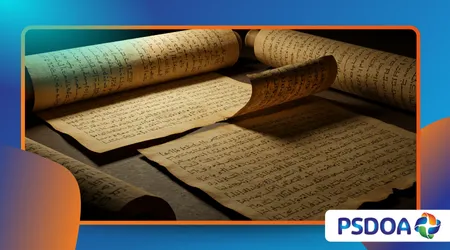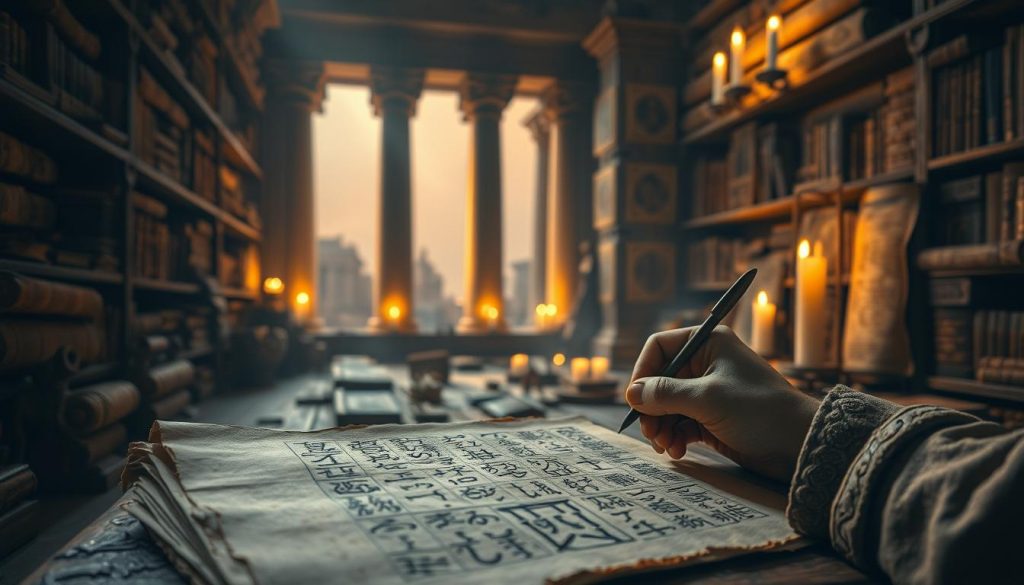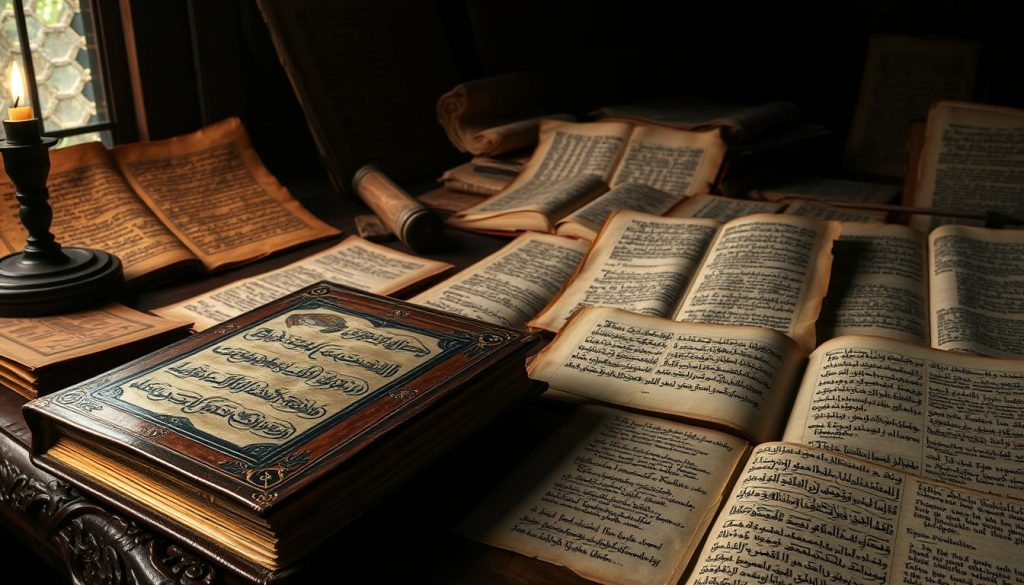Ancient texts How Ancient Texts Reveal Hidden Truths About the Past

Ancient texts are more than old paper—they’re time capsules. They hold clues to how ancient societies lived and thought. Every discovery, like the Dead Sea Scrolls, reshapes our view of history.
Anúncios
Today, tools like multispectral imaging help us read damaged texts. These discoveries keep rewriting history, showing us the past is full of surprises. These fragile pages connect us to forgotten voices, revealing how old ideas still influence us today.
The Enduring Mystery of Ancient Texts
Thousands of years after they were made, ancient texts still amaze and teach us.
These artifacts, found on stone, papyrus, or clay, are more than old relics. They open doors to understanding how ancient writing systems shaped cultures and continue to spark our curiosity today.

Anúncios
What Constitutes an Ancient Text?
Experts define ancient texts by their age, material, and what they say. A text from 3,000 years ago or older is often considered ancient.
We see examples in Egyptian hieroglyphs, Mesopotamian cuneiform, and medieval European parchments.
Each type of material, from delicate papyrus to sturdy clay tablets, shows the technology and culture of its time. Today, efforts to preserve these texts help them last for future study.
Why Ancient Writings Continue to Fascinate Us
“Every ancient text is a whisper from the past demanding to be heard.”
People are captivated by these pieces of history because they share our common hopes and struggles.
The historical fascination with texts like the Epic of Gilgamesh or the Voynich Manuscript comes from their ability to make ancient times relatable.
They show us that cultural heritage is about more than just leaders and battles—it’s about everyday lives and beliefs.
The Bridge Between Past and Present Knowledge
Ancient texts connect us to lost and rediscovered innovations. They include Babylonian math, Greek medicine, and Roman engineering. By studying these texts, scholars see how ideas have changed over time.
For example, studying ancient writing systems like Linear B or Mayan glyphs helps us understand not just language but also societal values. These texts show that our quest for knowledge never ends.
Fundamental Types of Ancient Texts Across Civilizations
Thousands of years later, ancient writings still speak to us through four core categories. Each reveals a distinct facet of life in antiquity, from spiritual beliefs to scientific breakthroughs.

| Type | Key Examples | Civilizations |
|---|---|---|
| Religious and Spiritual | Dead Sea Scrolls, Vedas hymns | Jewish, Indian |
| Administrative/Legal | Hammurabi’s Code, Roman laws | Babylonian, Roman |
| Literary Works | Epic of Gilgamesh, Homer’s Odyssey | Mesopotamian, Greek |
| Scientific/Medical | Hippocratic texts, Ayurveda | Greek, Indian |
Religious and Spiritual Manuscripts
Ancient religious texts like the Egyptian Book of the Dead guided spiritual practices. The Rigveda and early Quranic fragments show how faith shaped societies.
Administrative and Legal Documents
Historical legal documents such as the Code of Hammurabi codified laws. Clay tablets from Mesopotamia recorded trade deals and land disputes.
Literary Works and Poetry
Ancient literature includes the Epic of Gilgamesh and Sanskrit plays. These works preserved myths and moral lessons across generations.
Scientific and Medical Treatises
Ancient science and medical manuscripts like Galen’s works detail anatomy. The Ebers Papyrus lists herbal remedies for ailments.
How Historians Extract Truth From Ancient Documents
Unraveling the past starts with rigorous historical authentication. Scholars use document analysis to spot forgeries and date manuscripts. Let’s break down their tools:
- Paleography: Experts study ink, paper, and handwriting to link texts to specific time periods or cultures.
- Textual Criticism: Comparing variations in ancient copies reveals original meanings and later additions.
- Contextual Interpretation: Placing writings within political, religious, or economic contexts uncovers hidden agendas.
| Method | Goal |
|---|---|
| Paleography | Identify writing style and material clues |
| Textual Criticism | Spot discrepancies between copies |
| Contextual Interpretation | Understand motives behind the text |
A document analysis of the Dead Sea Scrolls showed scribes altered phrases to fit evolving religious beliefs. Even tiny details, like a faded ink stain, can rewrite history. “Every mark is a clue,” says historian Dr. Elena Marquez, “combining science and intuition is key.”
These techniques turn fragments into stories—proving ancient texts still speak to us today.
Learn more: Ancient technologies that were more advanced than they seemed.
Groundbreaking Discoveries That Rewrote History
Archaeological discoveries keep surprising us, showing that history is full of historical revelations yet to be found. Three finds have changed how we see ancient societies:
- Vindolanda Tablets (UK): These Roman-era wooden tablets, found in northern England, gave us ancient civilization insights into daily life. Before they were found, Roman soldiers seemed far away. But the letters told of personal stories—like requests for beer and birthday wishes. They even mentioned soldiers’ wives, changing how we see military life.
- Nag Hammadi Library (Egypt): Hidden for 1,600 years, these Gnostic Christian texts forced a revised history of early Christianity. Their 1945 discovery showed there were many early Christian beliefs. This contradicted the idea that early Christianity was uniform.
- Mawangdui Silk Texts (China): Excavated in 1973, these 2,000-year-old silk manuscripts revealed advanced medical knowledge and philosophical debates. Before this, experts thought traditional Chinese medicine developed later than it did.
Each unexpected findings shows how shaky historical certainty can be. As we uncover more of the past, scholars must be open to change.
The next section will look at how decoding ancient scripts like Linear B and hieroglyphics uncovered more secrets.
Decoding Lost Languages and Writing Systems
For centuries, ancient writing systems were secrets. Scholars worked like detectives, solving clues to unlock lost languages.
These discoveries changed how we see ancient worlds. Three key moments changed our views of Egypt, Mesopotamia, and the Mediterranean.
“I have found the cipher to Egyptian hieroglyphics!” declared Champollion in 1822. His breakthrough with the Rosetta Stone showed symbols held 3,000 years of pharaonic history.
The Rosetta Stone and Egyptian Hieroglyphics
In 1799, soldiers found a black slab in Egypt. The Rosetta Stone had the same text in Greek, demotic, and hieroglyphics. Champollion spent years studying, linking symbols to sounds.
This hieroglyphic translation showed temple records and royal decrees, proving hieroglyphs were a language, not just art.
Cuneiform: Unlocking Mesopotamian Knowledge
Mesopotamia’s wedge-shaped cuneiform puzzled experts until the 19th century. Scholars like Henry Rawlinson deciphered it by studying Persian inscriptions.
They uncovered clay tablets with laws, poems, and trade records, revealing Mesopotamia’s advanced ancient writing systems.
Linear B and the Mycenaean Civilization
In 1952, Michael Ventris worked on Linear B tablets from Crete. He found Greek names like “Athene,” proving this script was Mycenaean Greek. This Linear B discovery confirmed Homer’s epics were based on real Bronze Age kingdoms.
Challenges in Preserving Our Textual Heritage
Keeping ancient texts safe is a never-ending task. Humidity, light, and pests can harm them. Experts work hard every day to save these precious items.
“Every page saved is a victory for humanity’s collective memory,” says a conservator at the Vatican Library, where teams use UV lights to detect hidden layers of text.
- Climate-controlled vaults slow deterioration of delicate materials
- Non-invasive imaging captures details from crumbling scrolls
- International partnerships share conservation best practices
Digital archiving is key in protecting our heritage. The British Library’s Turning the Pages scans manuscripts in 3D.
This makes texts available without risking the originals. But, deciding whether to see fragile texts in person or through scans is a big challenge.
Restoring ancient texts at places like the Egyptian Museum in Cairo uses old and new methods. They use AI to analyze ink. This way, future generations can study important texts. Supporting these efforts helps keep our cultural legacy alive.
Recent Revelations From Newly Discovered Ancient Texts
New discoveries are changing how we see history. Advanced tools like imaging and genetic analysis are uncovering secrets. These findings show the past is full of untold stories.
The Dead Sea Scrolls: Ongoing Insights
Research on the Dead Sea Scrolls is revealing new things. DNA tests on the parchment show where animals came from. This suggests ancient workshops and trade routes.
Each discovery adds to our understanding of Second Temple Judaism. It’s like peeling back layers of history.
Herculaneum Papyri: Texts Rising From Volcanic Ash
Mount Vesuvius buried Herculaneum, but its papyri survived.
Now, multispectral imaging can read the carbonized texts. We’re learning about Epicurean philosophy and legal documents.
AI is also helping to read fragile scrolls. These were once thought to be lost forever.
Oxyrhynchus Collection: Egypt’s Literary Treasure Trove
The Oxyrhynchus collection has over 500,000 fragments. Translators are finding lost Homer pieces, tax records, and even a shopping list. Each translation brings us closer to understanding Greco-Roman Egypt.
Modern Technology Meets Ancient Wisdom
Advances in digital humanities are unlocking secrets hidden for centuries. Tools like spectral imaging and 3D scanning let researchers study fragile artifacts without damaging them. Non-invasive analysis techniques reveal layers of text on palimpsests—medieval manuscripts reused by scraping off older writing. Imagine reading a 2,000-year-old scroll without ever touching the fragile papyrus!
- Spectral imaging detects ink traces invisible to the naked eye
- 3D scanning creates virtual models of rolled-up scrolls
- Computational linguistics algorithms reconstruct broken texts
“These tools give us eyes no human could ever have,” says Dr. Emily Carter, a Stanford University papyrologist. “They’re like time machines for knowledge.”
Projects like the Digital Dead Sea Scrolls let anyone explore high-resolution scans online.
Citizen science platforms like Ancient Lives let volunteers help transcribe papyrus fragments. Even damaged texts get new life through AI predicting missing words based on language patterns.
While traditional methods remain vital, these innovations show how computational linguistics and non-invasive analysis are rewriting what we know about the past. The future isn’t just about preserving the past—it’s about making it speak again.
How Ancient Texts Shape Our Understanding of Human Development
Ancient texts are more than old books. They are blueprints of our past.
They show how societies evolved, adapted, and innovated. Let’s explore three key areas where these documents reveal timeless truths about humanity.
Cultural Practices and Social Structures
Texts like the Rigveda or Code of Hammurabi reveal social hierarchies and rituals. Egyptian tomb inscriptions detail burial customs, showing how death was tied to cosmic beliefs.
These records trace how social history shifted from tribal systems to complex empires, proving traditions were both preserved and transformed over time.
Technological Innovations Documented in Ancient Writings
| Innovation | Source | Impact |
|---|---|---|
| Iron smelting | Hittite tablets | Revolutionized warfare and toolmaking |
| Canal systems | Mesoamerican codices | Supported cities like Teotihuacan |
Climate and Environmental Changes Through Textual Evidence
“Ancient records of droughts and harvests are vital for tracking climate shifts.”
Historical climate data from Chinese dynastic annals track famines linked to monsoon failures. Mesopotamian clay tablets note river floods, helping scientists map long-term weather patterns.
Such records show how societies adapted to environmental changes—a lesson for today’s climate challenges.
Ancient texts are time capsules. They teach us how societies balanced tradition with innovation, managed resources, and understood their world. Their stories remind us that understanding the past is key to navigating the future.
Conclusion: The Timeless Value of Ancient Written Knowledge
Ancient texts are more than old relics. They connect us to humanity’s earliest thoughts. Egyptian medical papyri guide modern medicine, and Babylonian star charts inspire today’s astronomers. These documents show us how we’ve progressed.
Thanks to preservation, we can see cultural continuity. We learn about beliefs and innovations over thousands of years. This lets us understand our shared human experiences.
These texts share our struggles and victories. They teach us about ethics, governance, and art. By studying them, we improve our critical thinking. We see how past societies tackled problems we still face today.
Digitization has made these treasures available to everyone. Libraries and online platforms like the Internet Archive offer access. This lets us explore cuneiform tablets and medieval manuscripts.
Engaging with these materials is more than just learning. It’s a way to honor our shared history. Whether it’s reading a translated Homeric hymn or analyzing Mayan calendars, we join a global conversation that spans centuries.
Ancient wisdom is not just for dusty shelves. It influences modern science, culture, and philosophy. As technology advances, so does our ability to share these stories.
By valuing our textual heritage, we ensure future generations can continue this exchange of ideas.
